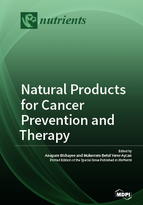Natural Products for Cancer Prevention and Therapy
A special issue of Nutrients (ISSN 2072-6643).
Deadline for manuscript submissions: closed (15 May 2018) | Viewed by 135777
Special Issue Editors
Interests: bioactive natural compounds; cancer prevention; phytopharmacology; molecular mechanisms
Special Issues, Collections and Topics in MDPI journals
Special Issue Information
Dear Colleagues,
This Special Issue, “Natural Products for Cancer Prevention and Therapy” is related to the 2nd International Conference on Natural Products for Cancer Prevention and Therapy, which will be held at Erciyes University, Kayseri, Turkey, 8–11 November, 2017.
Natural products represent an important source for the discovery and development of drugs for cancer prevention and therapy. Approximately, 80% of all drugs approved by the United States Food and Drug Administration during the last three decades for cancer therapy are either natural products per se or are based on, or mimicked natural products. With the introduction and refinement of new technologies, including genetic tools for production of secondary plant metabolites, combinatorial synthesis and high-throughput assays, it is likely that novel compounds from natural sources, including medicinal plants and marine organisms, would be identified and developed as cancer preventive and anticancer drugs with acceptable toxicity. In this Special Issue, contributions from eminent cancer researchers around the world will present recent advances on our knowledge on natural products in cancer prevention and therapy.
This Special Issue is open for submission from all participants of the aforementioned conference as well as any interested individual. It is expected that contributions will include original research papers, authoritative and up-to-date reviews, and commentaries on the following topics and areas:
- Natural products for the prevention and therapy of oncologic disease.
- Mechanism of natural agents for anticancer or cancer preventive effects.
- In vitro, in vivo and clinical studies related to natural agents and cancer.
- Use of natural products in conjunction with cancer chemotherapeutic drugs.
- Challenges and innovative approaches for anticancer drug development based on natural products.
- Novel strategy of enhancing bioavailability of natural products for cancer prevention and intervention.
- Production of anticancer natural agents using biotechnology.
- Pharmacokinetics and pharmacogenomic studies on anticancer phytochemicals.
Prof. Dr. Anupam Bishayee
Assoc. Prof. Dr. Mukerrem Betul Yerer-Aycan
Guest Editors
Manuscript Submission Information
Manuscripts should be submitted online at www.mdpi.com by registering and logging in to this website. Once you are registered, click here to go to the submission form. Manuscripts can be submitted until the deadline. All submissions that pass pre-check are peer-reviewed. Accepted papers will be published continuously in the journal (as soon as accepted) and will be listed together on the special issue website. Research articles, review articles as well as short communications are invited. For planned papers, a title and short abstract (about 100 words) can be sent to the Editorial Office for announcement on this website.
Submitted manuscripts should not have been published previously, nor be under consideration for publication elsewhere (except conference proceedings papers). All manuscripts are thoroughly refereed through a single-blind peer-review process. A guide for authors and other relevant information for submission of manuscripts is available on the Instructions for Authors page. Nutrients is an international peer-reviewed open access semimonthly journal published by MDPI.
Please visit the Instructions for Authors page before submitting a manuscript. The Article Processing Charge (APC) for publication in this open access journal is 2900 CHF (Swiss Francs). Submitted papers should be well formatted and use good English. Authors may use MDPI's English editing service prior to publication or during author revisions.
Keywords
-
Natural products
-
Medicinal plants
-
Phytochemicals
-
Nutraceuticals
-
Function food
-
Dietary agents
-
Cancer
-
Prevention
-
Treatment
-
Intervention
-
Inflammation
-
Molecular mechanisms








